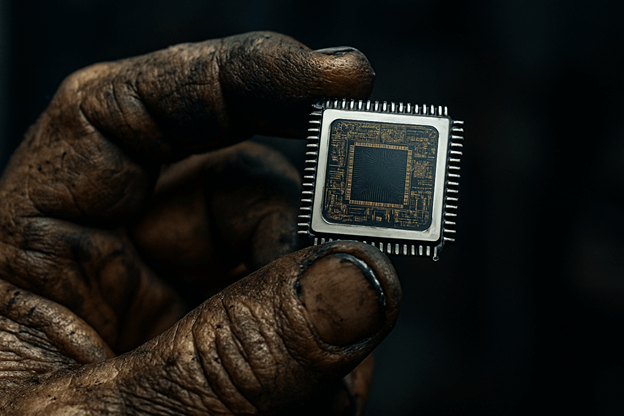
Revenge of the Rust Belt
Posted August 06, 2025
Chris Campbell
They said software would eat the world.
And… it did.
It devoured our attention, digested our professions, and gorged itself on every inefficiency it could find—from taxi dispatch to romance.
It flattened industries, inflated egos, and turned engineers into digital emperors.
But now? Software’s getting a little too soft around the edges.
It’s becoming bloated. Sluggish. Burping up AI-written tweets, dating simulators, and thirty different ways to tip your barista.
The world’s been eaten.
If the past thirty years have been about manipulating bits…
The next thirty will be about marrying those bits to atoms.
And if the five predictions below are even halfway right?
We’re about to witness the greatest economic remix since a pair of bicycle mechanics decided to try to give gravity a run for its money.
1. The Next Google Will Be an AI-Run Factory
The next Google won’t curate content.
It’ll curate atoms.
It’ll 3D print them, weld them, drone them out of hatchways, and route them through an AI-run supply chain.
Already, we’re seeing the world tilt back toward physical industry.
As of 2025, the global robotics industry is on a tear. The world now has over 4.2 million industrial robots in operation—double the number from just seven years ago.
Meanwhile, “industrial software”—the digital layer that tells these machines what to do—was worth $146 billion last year.
It's set to more than double by 2030.
And then there’s space…
The orbital economy was once a playground for dudes with Mars fetishes. Now it’s a cold, hard trillion-dollar sector in the making.
In 2022, the global space economy hit $450 billion. One year later? $570 billion. By 2030? Over a trillion.
We’re building again.
With AI. With hardware. With plasma drives and predictive maintenance. And the companies doing it don’t need likes. They need launch pads.
2. Ironworks Will Flip Ivy League
Shop class used to be a place you got sent when you couldn’t sit still…
Now it’s where you get sent because the future refuses to.
Across America, we’re witnessing a comeback of “learning by doing,” only this time the tools are 3D printers, CNC routers, and robotics kits instead of bandsaws and belt sanders.
STEM education has exploded.
Since 2010, STEM degrees are up 62%. In 2024 alone, nearly 100,000 Americans were trained in advanced manufacturing via apprenticeships—a 27% jump in just five years.
The Ivy League is starting to look over its shoulder.
Engineering schools are expanding while humanities departments are quietly downsizing. Robotics programs are getting new wings—and funding. Meanwhile, high school kids are building battle bots and launching weather balloons into the stratosphere.
If yesterday’s elite got MBAs, tomorrow’s might come with welding goggles and GitHub accounts.
3. Silicon Heartland Takes Over Silicon Valley
For decades, the American Heartland was treated like yesterday’s lunch—chewed up, swallowed, and forgotten by both coasts.
But in 2022, something pretty big happened: 76% of new U.S. manufacturing jobs went to the Midwest and South.
Three out of every four.
Places like Ohio, Tennessee, Alabama, and Michigan are quietly turning into advanced manufacturing hubs.
The GDP coming out of these regions is real: about 35% of the U.S. total. And yet—astonishingly—they receive just 10% of all venture capital funding.
To VCs, the Heartland’s undercapitalization is starting to look less like a lost cause…
And a lot more like an arbitrage.
4. Capital Flees Bits For Hardstack.
At the recent Reindustrialize Summit in Detroit, Christian Garrett of 137 Ventures said “it has become high status to invest in manufacturing,” signaling a cultural pivot among elite investors.
Manufacturing is no longer seen as repulsive drudgery, but as a source of technological prestige.
Consider that while global investment in the fintech sector fell by 50% in 2023…
Companies working on fusion power (yes, the “energy of the sun” stuff) raised over $7.1 billion.
And then there's defense.
In 2024, defense tech startups pulled in $31 billion globally. That includes everything from autonomous drones to next-gen radar systems to AI-powered battle networks.
Why?
Because complexity is setting the world on fire… and there’s only one way to keep the chaos at bay:
5. Redundancy is the New Resilience.
Remember when everyone was obsessed with being “lean”? Just-in-time supply chains. Single-supplier sourcing. Efficiency über alles.
Then reality kicked the door with layered bouts of neverending chaos since 2020.
Now? Companies are discovering that redundancy—once dismissed as wasteful—is actually a superpower.
Today, 73% of supply chain leaders have moved to dual-sourcing. That means they don’t just have a Plan B. They’ve got Plans C, D, and “Call Gary in Cleveland.”
Even cloud infrastructure has gotten paranoid.
Major tech firms now run servers in triplicate, across zones, regions, and alternate dimensions (probably).
In a world where everything depends on edge-case systems running perfectly… redundancy isn’t an expense. It’s an investment in not going extinct.
The Great Reversal
From SaaS to steel. From disruption to production. From tweets to torque.
Yes… there’s always a chance these predictions could spoil before they settle.
But if not?
Then 2025 is an inflection point. And few have any clue the gravity of what’s coming.
